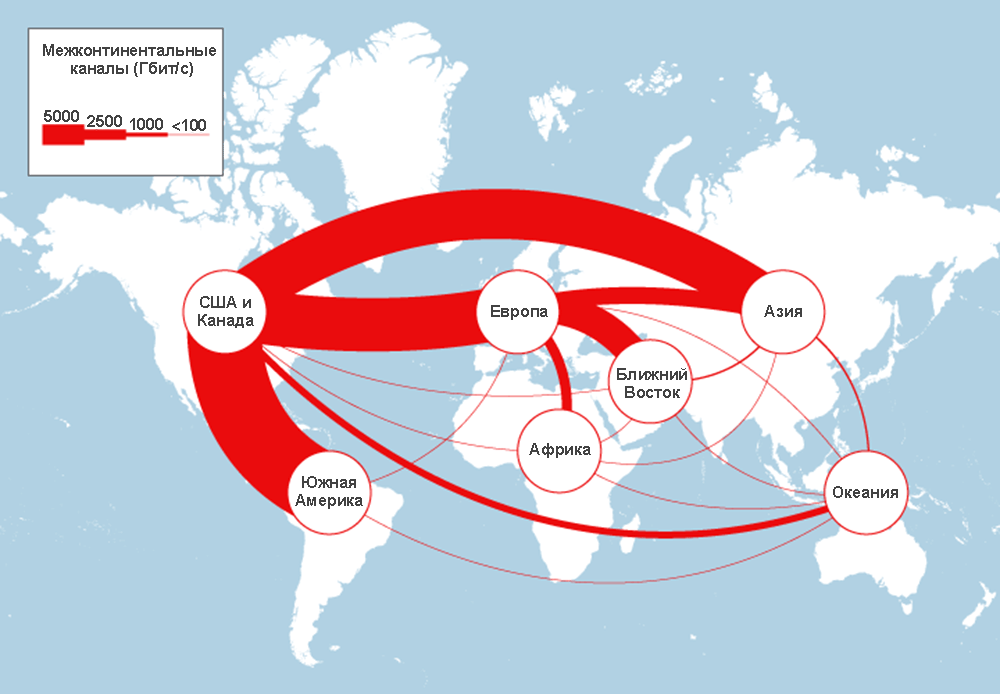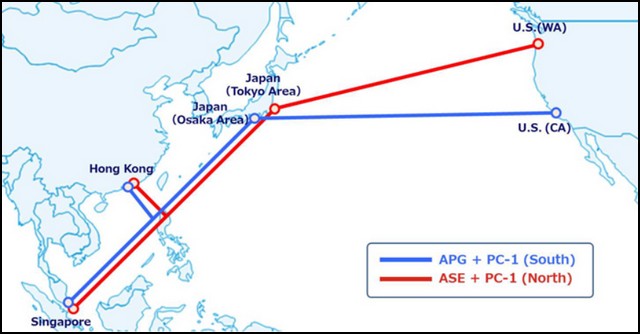54th terabit highway in Asia commissioned

On Habré, unnoticed, there was a single event that can have a big impact on the entire telecommunications industry. This is the introduction of the new Asia Pacific Gateway (APG) Internet trunk with a throughput of 54 terabits per second. The length of the fiber-optic communication channel amounted to 10400 kilometers. This ambitious project was implemented by the Japanese company NTT Communications for several years.
Interestingly, the theoretical throughput of 54 TB / s is more than originally planned. At the start of the project, the developers expected to achieve a throughput of 40 TB / s. But the theory is by theory, and on the map of Internet backbones the capacity of this channel is shown as 38.4 TB / s. Whatever it was, but it is also a very significant result. Asian countries have long awaited the launch of the new trunk line, since the Asia America Gateway (AAG) was often damaged, and in March of this year it was decided not to repair it.
The problem was that the repair team could not find the point of impulse, so there was nothing to repair.
')

The new highway will connect the Vietnamese city of Danang with the Japanese cities of Osaka and Tokyo. At these points, the cable will link to the PC-1, 640 gigabit backbone that connects Grover Beach, California and Harbor Point, WA. PC-1 has been working without any problems since 2001. The APG will also pass through a number of other settlements in Thailand, Vietnam, and South Korea.
Since the Winter Olympics will be held in South Korea, the project was tried to be implemented as quickly as possible, because video can be transmitted from the Games in ultra-HD quality via the terabit channel.
Three years ago, another highway, Southeast Asia-Japan Cable (SJC), was built in the same region. A significant portion of the funds invested here is Google. The theoretical bandwidth of SJC is 23 Tbps. Highway unites China, Brunei, Singapore and the Philippines. But it does not include Vietnam and South Korea in the overall system.
APG is funded by several major technology corporations, including Facebook. The social network provided developers with a large amount of investment (size unknown) in 2012. According to some local media , Facebook is investing in the highway because it is going to aggressively enter the Asian market. Perhaps this is true, since in May of this year the social network combined investment efforts with Microsoft. Both companies have decided to finance the construction of a submarine cable across the Pacific Ocean. This pipeline, after its installation, will have a record bandwidth of 160 Tbps. This is 256 times more than the PC-1.
Facebook and Google are financing another similar project for laying a 120-terabit highway, which is called PLCN.
In addition to all the above, in the Asia-Pacific region there is another mainline, Asia Submarine-Cable Express (ASE). Its length is 7800 kilometers. The highway connects the Philippines, Hong Kong, Malaysia and Singapore. ASE was commissioned in 2012.

2016 submarine cable map
According to information for 2014, 285 communication cables were laid across the ocean floor. 22 highways are not currently used. The average fiber life is 25 years. Interestingly, some companies, for example, Google, it is more profitable to lay their own cable across the ocean than to rent someone else's highways.
The most "wide" channel is the trans-Pacific cable FASTER. This highway with a length of 9,000 km has a capacity of 60 Tbps. It connects the highway to Japan and the United States, and Japan here plays the role of a hub between the United States and China.
Source: https://habr.com/ru/post/314542/
All Articles